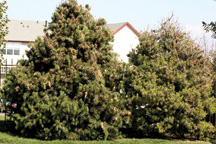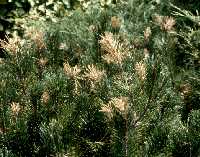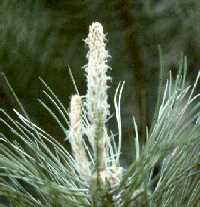by W.S. Cranshaw 1 (12/08)
Quick Facts…
 |
| Figure 1: Pinyon showing evidence of repeated pinyon tip moth injuries. |
- Tip moths are caterpillars that feed on and kill back new growth of various pines.
- Damage by tip moths is conspicuous but rarely threatens tree health.
- The southwestern pine tip moth that commonly infests Scotch, ponderosa and mugho pines is best controlled with insecticides applied as new needles are elongating.
- Tip moths on pinyon pine overwinter in or on the terminal growth of the tree.
Pine tip moths feed on and destroy new growth (terminals) of pines grown throughout most of
Colorado. Injury often is quite conspicuous, and infested plants may appear unattractive. Although little real injury to the health of the infested tree results from pine tip moth attacks,
tree growth can be delayed and the form altered to a bushier appearance.
 |
| Figure 2: Southwestern pine tip moth adult, Rhyacionia neomexicana. |
Tip moth injury can be diagnosed during early to midsummer by examining suspect shoots that have dried and shriveled. At this time, the damaging stage of the insect or old discarded skins can be detected. If the insect is not present, examine the damaged terminal growth to see if there is evidence of the internal tunneling typical of most tip moth injuries.
Insects Involved
The southwestern pine tip moth, Rhyacionia neomexicana (Figure 1), is the species mainly responsible for damage to young ponderosa, mugho and Scotch pines. Other tip moths in the same genus (R. bushnelli, R. zozana, R. fumosana) are found in the state but are much less common and damaging than the southwestern pine tip moth.
A different set of tip moths infests pinyon pine. Tip moths in the genus Dioryctria (primarily D. albovitella) damage pinyon in a manner typical of other tip moths, although it often is associated with a pinkish mass of pitch. Damage by another species, the pinyon pitch nodule moth (Petrova arizonensis), is more distinctive and produces a large, smooth nodule of purple-brown pitch as it feeds on pinyon terminals.
Life History
Pine tip moths have typical moth life histories, passing through four life stages: egg, larva or caterpillar, pupa and adult moth. It is the feeding of the larval stage that damages the trees (Figure 2). New infestations originate with eggs laid by the adult female moths, one generation per year.
The southwestern pine tip moth lays its eggs on buds and new shoots of pines in April and May. Eggs hatch about the time new shoots emerge from buds. The tiny larvae immediately begin to bore into the fresh young shoot tissue. The larvae feed and grow within the developing shoots through May, June and July, causing tip growth to die back beyond the feeding site.
 |
| Figure 3: Tip damage from larvae of pinyon pine tip moths. |
When feeding is completed, the full-grown caterpillar leaves the shoot to crawl down the trunk. On the side of the trunk, just below the soil line, it forms a white, paste-like, silken cocoon for pupating over the winter. Adult moths emerge the following spring on return of warm weather.
Tip moths infesting pinyon overwinter as partially grown larvae either in stem tissue or on the bark. The common tip moth (D. albovitella) lays its eggs during midsummer. The larvae emerge shortly afterwards but do not feed. Instead, they form a silken cocoon (hibernacula) on the bark for the winter.
The larvae resume activity in May, boring into the base of unopened buds. Often the larvae destroy the initially infested bud and move to a new shoot or developing cone, which they also mine. Irregular pitch masses often form at the injury site, superficially resembling those of the pinyon pitch nodule moth. Pupation occurs within the infested area, with the adult moths emerging to mate and lay eggs.
The pinyon pitch nodule moth lays eggs on the base of needles during early summer after the new growth has formed. Eggs hatch by early August, and the young caterpillars tunnel into a new shoot. While feeding, they form a distinctive, smooth, silk-lined pitch nodule and spend the winter as an almost full-grown caterpillar. They pupate wedged in an opening in the nodule.
 |
| Figure 4: Stage of shoot elongation to apply insecticide treatment for southwestern pine tip moth control. |
Control
Numerous natural enemies of tip moths exist and often reduce infestations to acceptable levels. In particular, various parasitic wasps develop within tip moth larvae, killing a large percentage of the population. As a result of these natural controls, tip moth infestations can vary widely from season to season. Trees taller than 10 feet often become less susceptible to tip moth injuries.
If necessary, tip moths can be controlled with insecticides. Pyrethroid insecticides that are labeled for use on shade trees, such as products containing bifenthrin, permethrin, or lambda-cyhalothrin, can be very effective against exposed larvae. The systemic insecticide acephate (Orthene) may kill small larvae that have already begun to tunnel into pine tips.
Proper timing is very important. Apply treatments for the southwestern pine tip moth when new shoots are elongating but before the needles are more than 1/2 inch long (“candling stage”) (Figure 3). For most pines, this typically occurs from late April through early May.
 |
| Figure 5: Pinyon tip moth larva exposed in terminal. |
Treatment timing for the pinyon tip moth is less well known. Thorough insecticide treatment in May should be effective if applied to new growth before overwintering Dioryctria larvae enter buds. Somewhat later treatments can still be effective at killing larvae moving from buds to developing shoots. Midsummer applications coinciding with egg laying in late July appear to be most appropriate for pitch nodule moth control.
1 Colorado State University Extension entomologist and professor, bioagricultural sciences and pest management. 4/96. Revised 12/08.
Go to top of this page.





